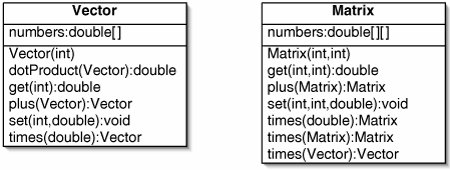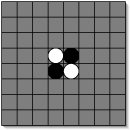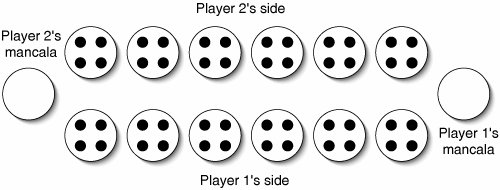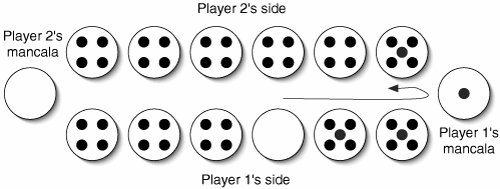Overloading
Projects
| 2.30 |
Write Vector and Matrix classes consistent with Figure 2-28. Figure 2-28. UML class diagram of the classes for Exercise 2.30. Since a particular Vector is not associated with a particular Matrix, nor vice versa, there is no arrow connecting the classes. (This item is displayed on page 63 in the print version)
|
|||||||||
| 2.31 |
Implement the game of Reversi (Figure 2-29).
|
| 2.32 |
Implement the game of Go-Moku (Figure 2-30).
|
| 2.33 |
Implement the game of Mancala (Figure 2-31). (Hint: Use a one-dimensional array of ints to represent the board. Number the pits counterclockwise. When sowing pebbles, if you are currently at pit i, the next pit is at position (i + 1) % 14, although your program must remember to skip this pit if it is the opponent's mancala.) |
|
Mancala |
|---|
|
Players: 2 |
|
Object: To have the most pebbles in your mancala (goal) at the end of the game. |
|
Board: The Mancala board consists of 14 pits, each holding a number of pebbles. The starting position is shown below. |
|
|
|
Play: On your turn, pick up all of the pebbles in any nonempty pit on your side of the board. Proceeding counterclockwise, sow one pebble in each pit until you run out. When sowing pebbles, include your own mancala, but skip your opponent's. An example of a first move is shown below.
|
|
Free Move: If the last pebble you sow lands in your own Mancala, you get to move again. |
|
Capture: If the last pebble you sow lands in a previously empty pit on your side of the board, you move that pebble, as well as any pebbles in the pit directly across the board, into your mancala. |
|
Game End: The game ends when, after either player's move, one player has no pebbles left in any of the six pits on her side of the board. The other player moves all of the pebbles left on his side of the board to his mancala. |
| 2.34 |
The Mancala rules in Figure 2-31 are the Egyptian rules. The Ethiopian rules make two changes: players may choose to sow pebbles either clockwise or counterclockwise around the board, and a move may not start from a pit containing only one pebble.The game ends when one player has no legal move. Modify the program from Project 2.33 to use the Ethiopian rules. (Hint: Remember that the % operator does not behave as modulo when the first operand is negative. This will be a problem if you evaluate (pit - 1) % 14 when pit is 0. You can get around this by first adding 14 to ensure that the first operand to % is positive.) |
Part I: Object-Oriented Programming
Encapsulation
Polymorphism
Inheritance
- Inheritance
- Extending a Class
- The Object Class
- Packages and Access Levels
- Summary
- Vocabulary
- Problems
- Projects
Part II: Linear Structures
Stacks and Queues
- Stacks and Queues
- The Stack Interface
- The Call Stack
- Exceptions
- The Queue Interface
- Summary
- Vocabulary
- Problems
- Projects
Array-Based Structures
- Array-Based Structures
- Shrinking and Stretching Arrays
- Implementing Stacks and Queues
- The List Interface
- Iterators
- The Java Collections Framework: A First Look
- Summary
- Vocabulary
- Problems
- Projects
Linked Structures
- Linked Structures
- List Nodes
- Stacks and Queues
- The LinkedList Class
- The Java Collections Framework Revisited
- Summary
- Vocabulary
- Problems
- Projects
Part III: Algorithms
Analysis of Algorithms
- Analysis of Algorithms
- Timing
- Asymptotic Notation
- Counting Steps
- Best, Worst, and Average Case
- Amortized Analysis
- Summary
- Vocabulary
- Problems
- Projects
Searching and Sorting
- Searching and Sorting
- Linear Search
- Binary Search
- Insertion Sort
- The Comparable Interface
- Sorting Linked Lists
- Summary
- Vocabulary
- Problems
- Projects
Recursion
- Recursion
- Thinking Recursively
- Analyzing Recursive Algorithms
- Merge Sort
- Quicksort
- Avoiding Recursion
- Summary
- Vocabulary
- Problems
- Projects
Part IV: Trees and Sets
Trees
Sets
- Sets
- The Set Interface
- Ordered Lists
- Binary Search Trees
- Hash Tables
- The Java Collections Framework Again
- Summary
- Vocabulary
- Problems
- Projects
Part V: Advanced Topics
Advanced Linear Structures
- Advanced Linear Structures
- Bit Vectors
- Sparse Arrays
- Contiguous Representation of Multidimensional Arrays
- Advanced Searching and Sorting
- Summary
- Vocabulary
- Problems
- Projects
Strings
Advanced Trees
- Advanced Trees
- Heaps
- Disjoint Set Clusters
- Digital Search Trees
- Red-Black Trees
- Summary
- Vocabulary
- Problems
- Projects
Graphs
- Graphs
- Terminology
- Representation
- Graph Traversal
- Topological Sorting
- Shortest Paths
- Minimum Spanning Trees
- Summary
- Vocabulary
- Problems
- Projects
Memory Management
Out to the Disk
- Out to the Disk
- Interacting with Files
- Compression
- External Sorting
- B-Trees
- Summary
- Vocabulary
- Problems
- Projects
Part VI: Appendices
A. Review of Java
- A. Review of Java
- A.1. The First Program
- A.2. Variables and Types
- A.3. Loops
- A.4. Interacting with the User
- A.5. Branching
- A.6. Methods and Breaking Out
- A.7. Constants
- A.8. Operators
- A.9. Debugging
- A.10. Coding Conventions
B. Unified Modeling Language
C. Summation Formulae
- C. Summation Formulae
- C.1. Sum Notation
- C.2. Sum of Constants
- C.3. Sum of First n Integers
- C.4. Sums of Halves and Doubles
- C.5. Upper Limit on Sum of a Function
- C.6. Constant Factors
D. Further Reading
Index
EAN: 2147483647
Pages: 216





